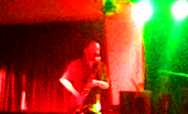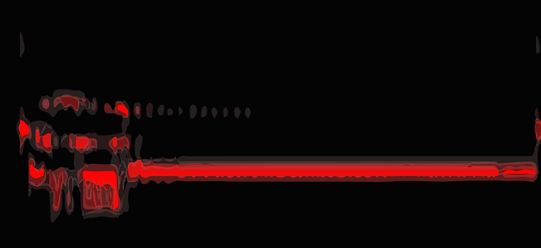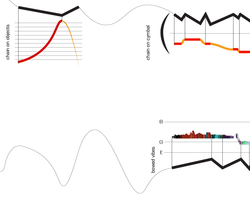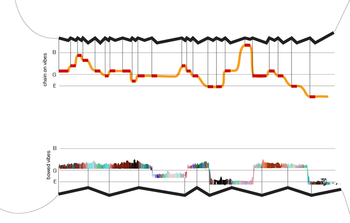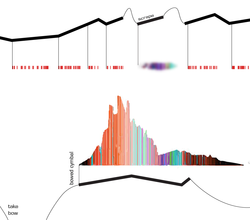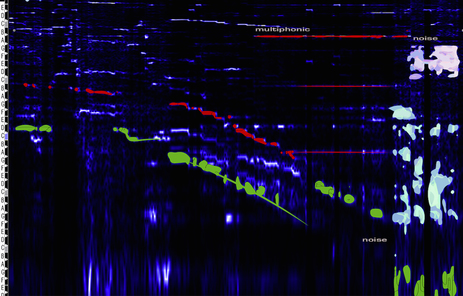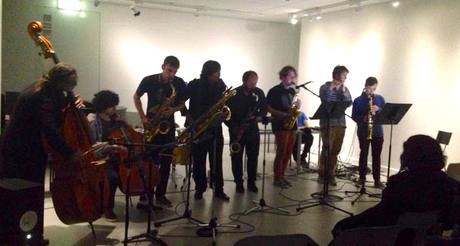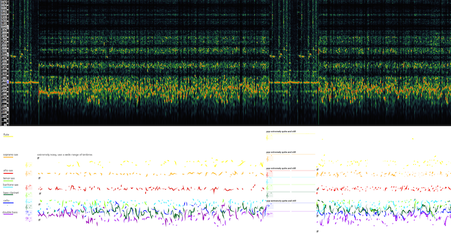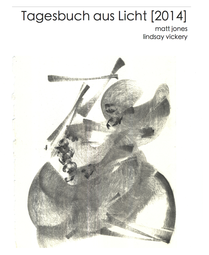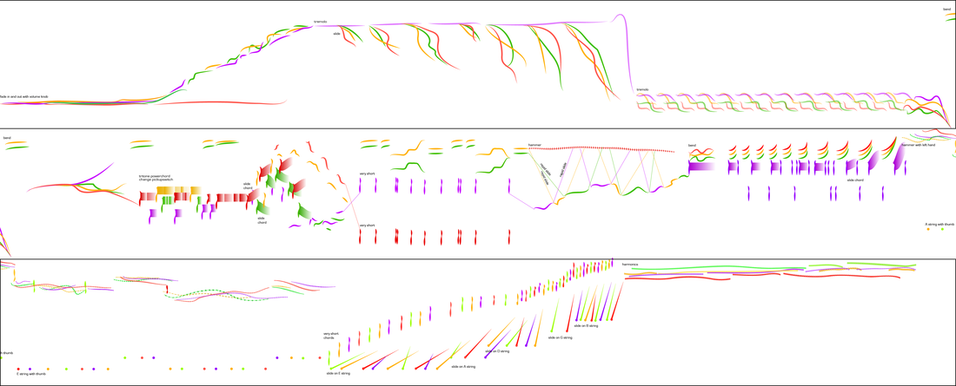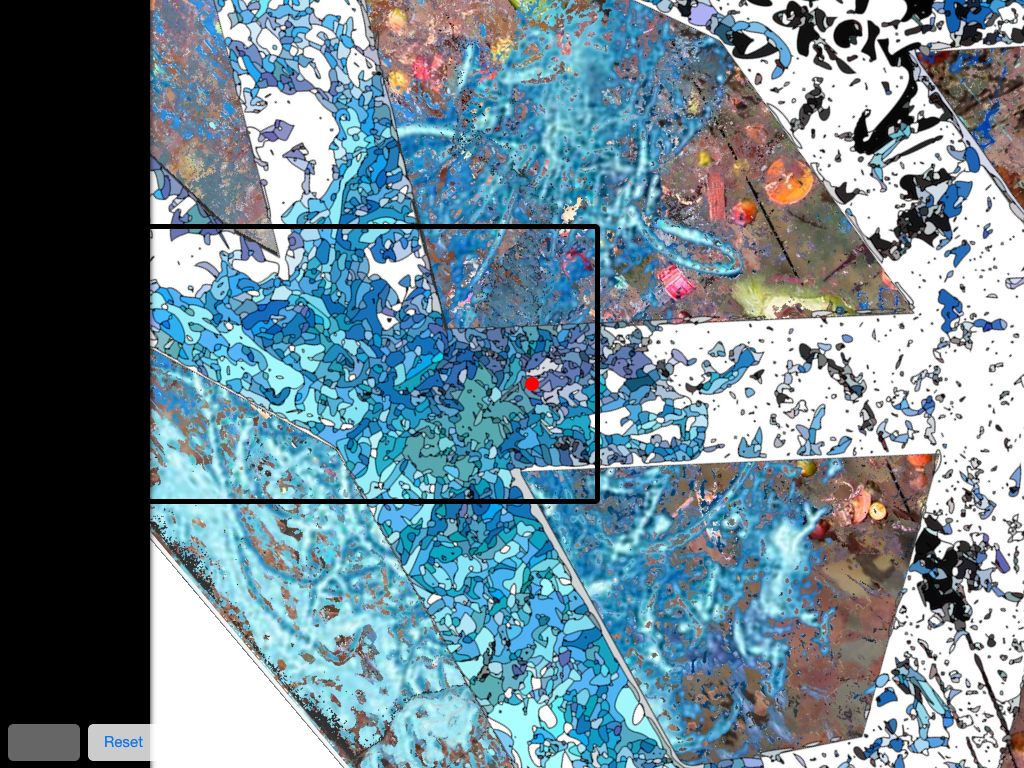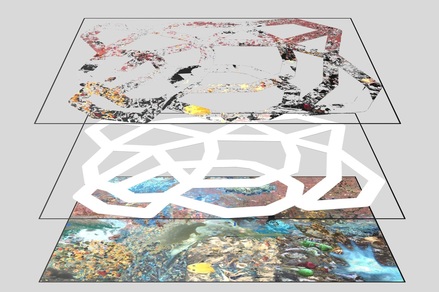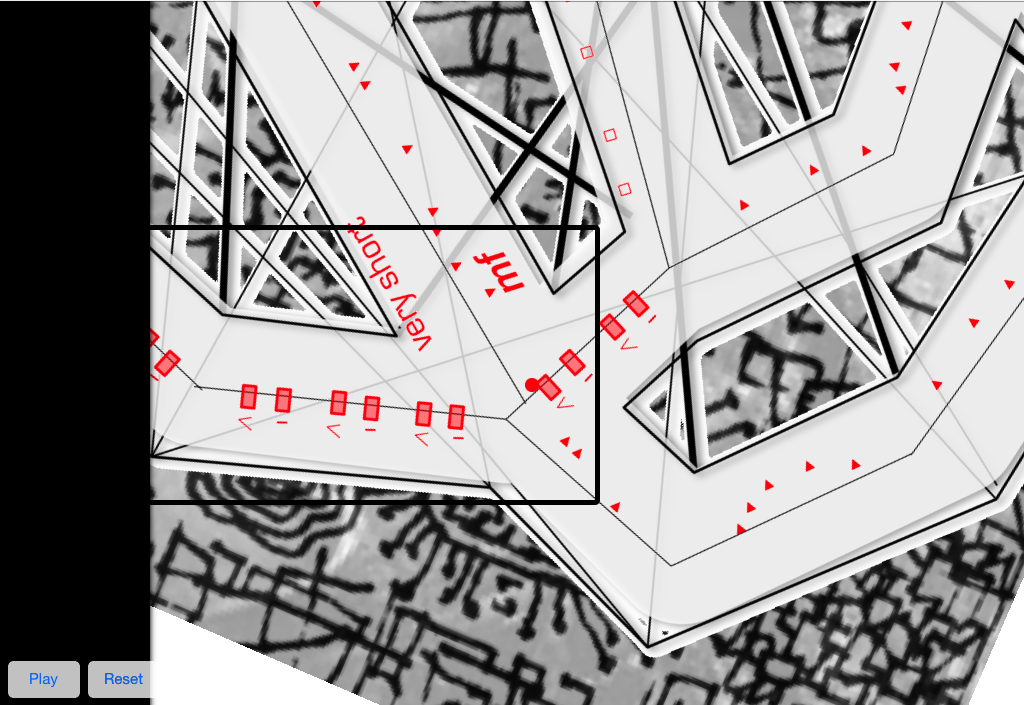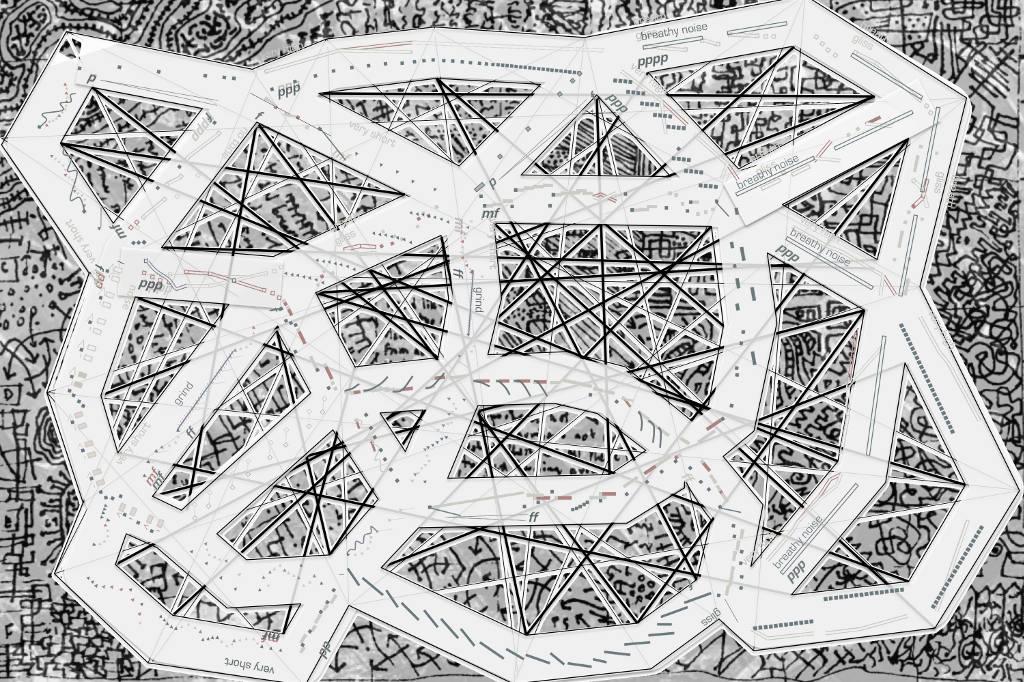2015
158 remnant [2015] bass clarinet and electronics
|
A work for Bass Clarinet and electronics. Exploring spectral sound processing and nonlinear performance instructions delivered via MaxMSP software. A complex routing system was developed allowing multiple audio processing techniques to be applied in varying combinations and parametrical configurations.
|
|
The work explores dividing the performance period into sections of varied length each with an individual performance instruction and electronic processing profile. The approach creates a variable nonlinear structure in which the contents are the same but the ordering is altered with each performance.
Performed at NoizeMaschin!! #43 at the Perth Artifactory on 13 Jan 2015.
Performed at NoizeMaschin!! #43 at the Perth Artifactory on 13 Jan 2015.
157 study no. 4 for no-input bass clarinet [2015] bass clarinet and feedback
156 inhabited matter [2015] 8.1 channel acousmatic work
|
inhabited matter is an 8 channel electroacoustic work derived from sonified images of natural forms such as plants, stones and bark. The sonified matter was then processed using a range of spectralisation techniques. 8 processed audio files were then distributed using frequency, amplitude, brightness and noisiness data derived from their own realtime analysis.
|
Performance:
20151120 Australasian computer music conference 2015 UTS, Sydney |
155 ...with the fishes... [2015] for viola, cello, double bass and electronics
...with the fishes... is a sibling to my 2013 work for Decibel silent revolution. As the title suggests (and despite the nod to The Godfather) the work is a reflection on the future of our oceans (as well as an acronym summing up the situation). Like silent revolution, a range of music notations (including fragments of Debussy's La Mer that wash through the score), are situated in the context of a collage of over 300 images and quotations by scientists, journalists and activists concerned with the state of things below the surface. These issues include the expansion of fossil fuel drilling into every ocean - including the arctic, rising sea-levels due to climate change, pollution from radiation leaks, jellyfish and algae blooms caused by fertiliser run-off, the thawing and release of ocean methane clathrate and the ever growing trash vortex. Although the predictions of the commentators quoted such Chris Hedges, Alan Weisman, Eric Grundhauser (Slate), Gwynn Guildford (Quartz) and Örjan Gustafsson differ - they range from severe to apocalyptic. ...with the fishes... began as an idea for a graphic novel I planned with my son Max and this idea also plays into the aesthetic of the work (and the quote about the fate of climate skeptics).
|
|
Blog
20150802 Performance: 20171125 Hochschule für Musik und Theatre, Hamburg. 20151120 Australasian computer music conference 2015 UTS, Sydney 20151009 silent revolution: The Firehouse Space, Brooklyn New York 20151007 nature forms: Hartt School of Music, Hartford 20150905 Decibel: Anime, PICA Performance Space |
154 residual drift [2015] for amplified bass flute and fixed media
|
Blog
20150823 Performance: 20151009 Lindsay Vickery: The Firehouse Space, Brooklyn New York (Zachary Rowden) 20150924 ShockoftheNew!, Spectrum Project Space, Perth (Kirsten Smith) |
In commemoration of the 50th anniversary of the death of Edgard Varésè, residual drift is derived from a sonogram of his percussion work Ionisation (1931). Apart from alluding to the origin of the piece from the residue of a Varésè work, the title uses terms from particle physics which perhaps bear the same "fantastic" qualities in our own time that the term ionisation did in 1931. he sonogram was used as the basis for a score for amplified bass flute and was resonified to create an electronic component. Both the score and the electronics can be played via the Decibel Scoreplayer. To create the the electronic component each pixel of the sonogram was rendered as a sine tone, with frequency and amplitude determined by vertical height and shade respectively. The graphical score was rendered in broadly three hues corresponding to varied tonal qualities of the bass flute. The method of rendering these qualities is determined by the performer. The work can theoretically be performed simultaneously with Ionisation.
|
153 The Miracle of the Rose [2015] for percussion duo and fixed media
|
Jean Genet's The Miracle of the Rose made a great impression on me many years ago. Recently I discovered a very old photocopy I had made of a short passage of the work wedged in a photo album from the 80s. In it Genet considers the mastery of time through the performance of gestures with infinite slowness - that "Eternity flows into the curve of a gesture". This text on the time-altering nature of solitary confinement forms the basis of my work for The Sound Collectors.
|
The text itself - read by Australian/French artist Emmanuelle Zagoria - becomes the gesture that is curved in time. The spoken phrases are transduced for the two percussionists into gestures exploring their cadence and timbre via varied instruments and notational approaches.
|
|
En cellule, les gestes peuvent se faire sur une extrême lenteur. Entre chacun d’eux, on peut s’arrêter. On est maître du temps et de sa pensée. On est fort d’être lent. Chaque geste s’infléchit selon une courbe grave, on hésite, on choisit. Voilà de quoi est fait le luxe de la vie en cellule. Mais cette lenteur dans le geste est une lenteur qui va vite. Elle se précipite. L’éternité afflue dans la courbe d’un geste. On possède toute sa cellule parce qu’on en remplit tout l’espace avec la conscience attentive. Quel luxe d’accomplir chaque geste avec lenteur, même si la gravité ne réside pas en elle. J.G. (1946) |
In the cell, gestures can be made with extreme slowness. You can stop in the middle of one. You are master of time and of your thinking. You are strong by dint of slowness. Each gesture is inflected in a flowing curve. You hesitate. You choose. That is what the luxury of cell life is composed of. But this slowness of gesture is a slowness that goes fast. It rushes. Eternity flows into the curve of a gesture. You possess your entire cell because you fill its space with your engrossed mind. What a luxury to perform each gesture slowly, even if it be lacking in gravity. |
|
|
Performance
20150311 Piñata Percussion, University of Western Australia 20160722 Piñata Percussion Australian Percussion Gathering 2016. Griffith University, Brisbane. 20150717 The Sound Collectors: Gesture, Tura Scale variable Series Concert 2, PICA |
152 between-states [2015] for bass flute, bass clarinet and fixed media
|
In between-states the same audio material of acoustic bass flute and bass clarinet is explored through multiple electronically processed transformations. A pre-recorded audio track is constructed from a patchwork of the transformations. The live performers read from an annotated spectrogram score of the audio track, mirroring the visual shapes with their acoustic sounds. The performers are coordinated by reading from a scrolling score with accompanying two channel audio track on iPad. The relative pitch of the notated events is indicated by a pitch-guide that remains fixed on the left of the screen.
Blog:
20150812 Performance: 20150611 Kirsten Smith - Bass Flute, Lindsay Vickery - Bass Clarinet, between-states, Murdoch University Sound Stage |
151 acid fury [2015] for piccolo, saxophone quartet, bass clarinet, cello, double bass and fixed media
150 Tagesbuch aus Licht [2015] for electric guitar and electronics 27m (with Matt Jones)
|
9 improvisations by Matthew Jones (Guitars) and Lindsay Vickery (Electronics) with 8 flumographs by Matthew Jones.
Available for free on the iTunes store. 1. solaster 2. lunatic 3. mericarp 4. reperible 5. filoselle 6. gobemouche 7. besom 8. leangle |
149 mezareon [2015] for guitar orchestra
|
|
Performance:
20150507 Sound Spectrum Festival, Spectrum Project Space, Perth. |
148 flitter [2015] for soprano saxophone, electric guitar, harp and independent click-tracks
|
The fourth in the series of polytempo experiments the includes whorl, particle+wave and zwitschern. The three instruments follow the same tempo curves used in zwitschern, but the clicks are offset from one another by a third of their current tempo.
|
Performance
20150424 Greywing Trio: Sound Unbound, Spectrum Project Space |
147 here, apparently, there was time for everything [2015] for saxophone, piano and percussion
The notated score is a spectrogram transcription based on "no-input bass clarinet" feedback that is processed by variable-speed delay. It was written for Mix't Matthew Styles, Paul Tanner and Adam Pinto.
Performance
20170423 Lindsay Vickery: Sounds Unbound, Spectrum Project Space
20150424 Greywing Trio: Sound Unbound, Spectrum Project Space
20170423 Lindsay Vickery: Sounds Unbound, Spectrum Project Space
20150424 Greywing Trio: Sound Unbound, Spectrum Project Space
|
|
|
146 trash vortex [2015]
The score for trash vortex is a collage of images of junk from the ocean gyres. Due to the Earth's rotation, major bodies of water form vortices which have been accumulating non-biodegradable junk - principally plastics. There are presently calculated to be 270, 000 tons of plastic in the oceans, gradually being consumed by ocean life and entering the food chain. In this work the performers circulate around the "trash vortex' score. The score comprises three layers: a graphical score, a rhizomatic path and a "trash vortex" collage. The path layer periodically becomes transparent causing the graphical score to appear to "submerge" into the background collage - making it more challenging for the performers to read. The score (in the Decibel Scoreplayer) sends messages about the path layer's status to a MaxMSP audio processing patch, which in turn alters the audio processing of the live instruments to reflect the state of the score.
trash vortex is potentially incomplete and is intended to form the final section of a larger work that begins with a scrolling score before the performers disappear into the vortex.
trash vortex is potentially incomplete and is intended to form the final section of a larger work that begins with a scrolling score before the performers disappear into the vortex.
|
|
Performances:
20150205 Spectral Manipulation Feb 05 2015 at 08:00 pm A300 California Institute of the Arts (Amy Knoles - Percussion, James Rushford - Piano and Lindsay Vickery - Bass Clarinet) |
145 detritus [2015] for electric guitar, bass clarinet, double bass and electronics
Detritus is a rhizomatic score for three instruments exploring the idea of transforming notation by combining foreground and background layers. The score (in the Decibel Scoreplayer) provides an overview (above right) for the audience showing the current position of each player and a "performer view" displaying in a "zoomed-in" and always upright version of the score for the players. The score has three layers - notation, pathways and background. The central, white, pathways layer periodically fades in and out transforming the appearance of the notation to the performers. The scoreplayer communicates with an audio processing patch in MaxMSP via OSC reporting the state of the pathways layer resulting in changes in the audio processing of the instruments.
|
|
Performances:
20170407 Sonic Wonderment Revisited 7 April 2017, WAAPA 20161216 Decibel: Tokyo Metropolitain University 20160714 NIME2016, Griffith University, Brisbane 20160305 Nature Forms: lindsay vickery and ANU New Music Ensemble, collected resonances, ANU Canberra. 20150130 Þögla Byltingin | Silent Revolution, Dark Music Days Festival, Reykjavik, Kaldalón, Harpa Friday January 30th 2015 10:00 pm 20150326 Sounds Unbound, Spectrum Project Space, WAAPA Perth. |

